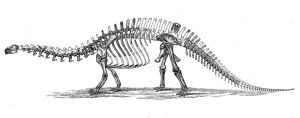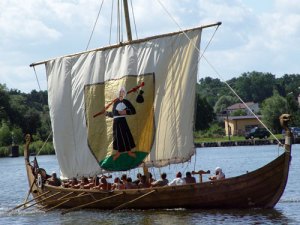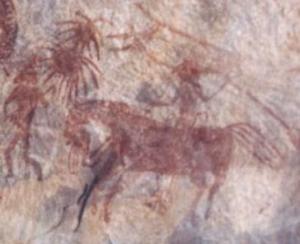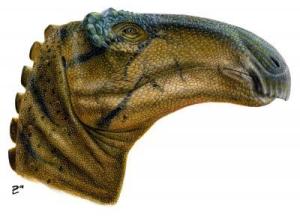Paleontologists, like everyone else, make their share of mistakes. Unfortunately, paleontological mistakes become incorporated into scientific literature and sometimes (as in this case) also into the collective consciousness of the general public, reverberating through decades and centuries, long after they are left behind by the science that spawned them.
Such is the case with Brontosaurus. Long the icon of the dinosaur world, this genus of herbivorous sauropods whose name means “thunder lizard” was a mistake. An Apatosaurus that had an inaccurate reconstruction of its head added to the original display (because the specimen being used was missing its head when it was discovered), it now exists in science only as a casebook example of phylogenetic inference run amok. It is also a casebook example both of how we sometimes let our prejudices guide our decisions and how scientific competition is not always a good thing.
The original specimen, still in the great hall of the Peabody Museum of Natural History, at Yale University, in New Haven, Connecticut (USA), went on display in 1905, some six years after Marsh’s death. It remains in its original pose, based on the early twentieth belief that the animal walked with its head drooping and its tail dragging the ground behind it. It has, however, had its head replaced with the correct one for the species. By contrast, the specimen in the American Museum of Natural History shows what is referred to as the “modern posture”, with its head sticking forward just higher than its body and its tail raised to body level, to demonstrate how scientists currently believe the animal actually looked in life.

The original conception of how Brontosaurus excelsus, now Apatosaurus excelsus looked, with its head drooping and its tail being dragged behind.
Image Credit: Image is from Wikipedia Commons and is in the public domain.
So, how did all of this happen? The story goes something like this… From the late 1860s onward, two American paleontologists, Othniel Charles Marsh and Edward Drinker Cope were engaged in an open feud over the discovery of dinosaur fossils in the American West. The feud began “back east” as they use to say in the West, when Cope accused Marsh of paying quarrymen in New Jersey to divert to himself fossils that had been paid for by and promised to Cope. Soon, the two men were engaged snipping at each other’s fossil finds, feuding over fossil hunting rights in the western territories, and in general name calling and accusations. They tried to out-do each other by finding and naming the largest number of fossils and the biggest specimens they could find.
In the midst of this feud, in 1879, Marsh discovered a very large specimen of a sauropod dinosaur at Como Bluff, in southeastern Wyoming (USA). It was larger and much more complete than anything that had been found up to then, but it had one little problem. It was missing its head. Marsh was convinced that it was an entirely new genus and species, which he named Brontosaurus excelsus. The species name (excelsus) means “highest or sublime” and is intended to refer to the fact that it had the greatest number of sacral vertebrae of any sauropod known at the time.
Scientists started preparing the specimen for display. Missing bones were replaced using known examples from close relatives of Brontosaurus. The specimen was missing its feet, so sauropod feet that had been found at the same quarry were used. But, the head was still a problem. What to do? What would the head of such a beast look like? Marsh, being a thorough nineteenth century man, dismissed many of the proposal as being too effete for such a large animal. Surely its head would be robust, virile (one at the time might have been tempted to say manly). So, Marsh had a head constructed from bones of similar species that looked the way Marsh thought Brontosaurus‘ head should look. This composite skull (which we now know to be mostly made of Brachiosaur bones) was duly created and fitted to the mounted skeleton. Thus, it was not the (relatively) delicate skull of Apatosaurus excelsus, that would eventually be deemed to be the true appearance of the creature.

Othniel Charles (O.C.) Marsh, who found and named Brontosaurus.
Image Credits: Image is from Wikipedia Commons and is in the public domain.
Marsh, who died in 1899, never lived to see his specimen on display. Cope had already died in 1897, and their great feud, now known as the Bone War, had died with them.
When it went on display, Brontosaurus was the first sauropod to be seen by the public, and it created a sensation. It captured the public’s imagination and became a cultural icon of the science of paleontology. And there it remained through most of the twentieth century, captured in a million images ranging from hollywood renditions in movies to corporate images for oil companies, to a thousand and one cartoon creations and magazine images.
But, even before Brontosaurus went on display, its name and identity were being challenged. In 1903, paleontologist Elmer Riggs took another look at the fossils. He agreed with Marsh that B. excelsus was likely its own species, but decided that it had too much in common with Apatosaurus to be a distinct genus. Riggs reclassified the specimen as Apatosaurus excelsus, where it has remained to this day. Most scientists over the years have agreed with him. Yet, in the eyes of the public, it was always Brontosaurus.
Why, you might ask, didn’t Riggs reclassify Apatosaurus into Brontosaurus, since the latter was clearly the better known and more popular name? The reason for that is the rules surrounding the naming and renaming of animals in biology. This is governed by rules set down by the International Commission on Zoological Nomenclature (ICZN). According to those rules, if two genera are determined to be the same, then the one that was named first has priority and the animal(s) in the one named later are reclassified into the older one. It should be noted here that the same rule applies at all levels of scientific nomenclature (family, genera, species, etc.). Since Apatosaurus had been named in 1877 (ironically by Marsh himself), Apatosaurus won, and Brontosaurus became what is known as a “junior synonym” and was discarded from formal use.
It might have remained that way, with the general public knowing Brontosaurus and scientists knowing Apatosaurus, but for the U.S. Postal Service. In 1989, they issues a series of four dinosaur stamps, one of which was of Brontosaurus. A number of paleontologists went ballistic, accusing the post office of promoting inaccurate science. From that hoopla, the general public first became aware of the whole Brontosaurus fiasco and the fact that their “beloved” Brontosaurus was actually something else. In the eyes of some in the public, it called into question the reputation that paleontologists had worked so hard to established. It seemed that the Bone War had done more harm to paleontology, nearly a century after it had ended.
Others point out that it has shown paleontology as a science that learns from its mistakes and is honest and strong enough to make the necessary changes and go on.
In any case, it certainly shows that men of science can have their own issues. Aside from the rivalry between Cope and Marsh, it shows how we are slaves to our times. Marsh could not see that his fossil’s head was smaller and more delicate than the burly version he envisioned, largely because his society said it was supposed to be that way.
It also demonstrates the nineteenth century European fascination with naming and categorizing things, often to the exclusion of anything else, especially if that something else disagreed with the way they thought things should be.
Alas, we have our own prejudices. Will we be able to stand the scrutiny of our successors a hundred years from now? Only time will tell, but in any event, Brontosaurus was the dinosaur that never was, except in our own imaginations.






